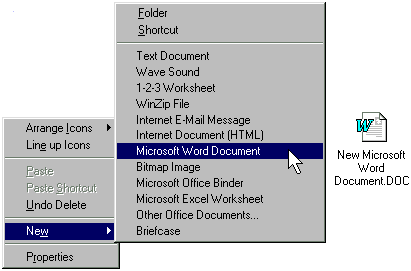|
This is a continuation of Basic Windows 95 Tips - Part 1, with many more "must-know" tidbits. These "basics" are considered necessities!
Make an Emergency Startup Disk Make an Emergency Startup DiskTo create a complete Emergency Startup Disk (something EVERYBODY ought to have), double-click the Add/Remove Programs icon in Control Panel, and then click the Startup Disk tab. This will create a single BOOTABLE floppy disk for use in emergencies. Creating a New File QuicklyCreate a new file by using the right mouse button to click the desktop or folder, point to New, and then click the type of file you want to create from the list.
Taskbar BackgroundTo open the taskbar's context menu when the taskbar is full, move the mouse pointer to the edge of the taskbar, and then use the right mouse button to click the taskbar. You can also do this to drag the taskbar to a larger size, when you see that double-headed arrow. Hiding the TaskbarUse the right mouse button to click the Start button, and then click Properties. Click the Taskbar Options tab, and then click Auto Hide. When the mouse moves near the taskbar area, the taskbar appears. Another method involves simply grabbing the taskbar and shrinking it to a small sliver. This way it won't pop back up until you grab it and resize it again. Moving the TaskbarWhy settle for the default location of the Taskbar, which is at the bottom of your screen? You can drag the taskbar to any side of the desktop area. Just grab it with your mouse (left-click any blank spot) and hold the button while you drag it to other edge of the screen - left, right or even the top. Using Backup to back up your filesYou can use Backup to back up files on your hard disk. You can back up files to floppy disks, a tape drive, or another computer on your network. When you've made a backup file, you can restore it if your original files are damaged or lost. Windows 95 Backup should be located in your Accessories / System Tools folder. Using the Find ToolTo find a file, mail message, computer, or file on The Microsoft Network, use the Find command on the Start menu. In addition, you can save a search in the Find dialog box by clicking Save Search on the File menu. For an even more powerful Find, download one of the Microsoft Powertoys called FindX. This utility enhances the original, making it more powerful than ever! Click here to download FindX now!
Tips for Using the Taskbar ClockHold the mouse pointer over taskbar clock to see the date. Double click the taskbar clock to set the system time, date, and time zone. To remove the clock from the taskbar:
Get to the bottom of your foldersIf you've got a folder window open and want to get to the bottom of it, don't use the scroll bar. Just press <Ctrl>+<End>. And if you're at the bottom or somewhere in the middle of a folder window and want to return to the top, press <Ctrl>+<Home>. Program Manager and File Manager are still hereProgram Manager and File Manager are part of Windows 95, and they work exactly as they did in the previous versions of Windows. Both have unique advantages. For example, File Manager is much faster than Explorer. If you miss Program Manager and File Manager, you can find PROGMAN.EXE and WINFILE.EXE in the \WINDOWS folder and create shortcuts to them on your desktop. What's that on the taskbar?If you hold the mouse pointer over minimized folders or applications on your task bar, a ToolTip will pop up and give you the folder or application, along with document names.
Climb back to the topFrom the View menu of any open folder, select Toolbar to bring up the folder toolbar. The button on the left is the Up One Level button. Click on the button repeatedly to move toward the root. Changing the Sort Order in ExplorerYou can easily change the sort order of any of the fields in Explorer windows. First you have to be in "Details View". From the menu, this is under "View / Details" or you can click the last icon on the toolbar. The toolbar is enabled under "View / Toolbar". For example, just click on the Name button above that column to change the sort order from ascending to descending, another single click after that will toggle the sort order. The same works for the rest of the fields too; Size, Type and (Date) Modified. The example below toggles the sort order for Size.
Make your Start menu more manageableYou can easily squeeze out an additional 50% of Start Menu real estate by displaying small icons instead of those space-hogging large ones that you see by default. To do this, right-click anywhere on an empty spot on the Taskbar, select Properties, and check "Show small icons in Start menu".  Return to Top of Page Return to Top of Page
To Main Page |
Start Me Up! Best experienced with All other product names are trademarks or registered trademarks of their respective owners. |
 In this Issue:
In this Issue:



